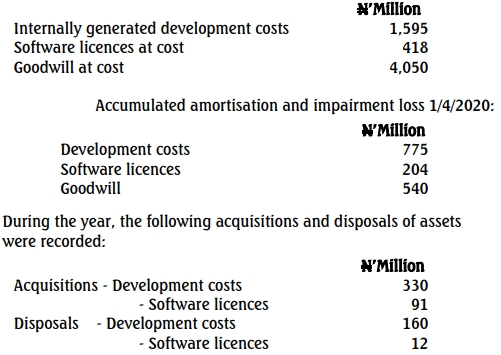The following is the trial balance of Almajiri Nigeria Limited as at September 30, 2018:
| Account |
Debit (₦’m) |
Credit (₦’m) |
| Revenue |
|
60,000 |
| Cost of sales |
40,800 |
|
| Distribution costs |
2,900 |
|
| Administrative expenses |
4,440 |
|
| Interest on bank borrowings |
40 |
|
| Research and development costs |
1,720 |
|
| Leasehold property (at valuation Oct 1, 2017) |
10,000 |
|
| Plant and equipment (at cost) |
15,320 |
|
| Plant and equipment (accum. depr. at Oct 1, 2017) |
|
4,920 |
| Capitalised development expenditure (Oct 1, 2017) |
4,000 |
|
| Development expenditure (accum. amortiz. at Oct 1, 2017) |
|
1,200 |
| Closing inventory (30 Sept 2018) |
4,000 |
|
| Trade receivables |
8,620 |
|
| Bank |
260 |
|
| Trade payables & provisions |
|
4,760 |
| Preference dividend paid |
160 |
|
| Dividend paid on ordinary shares |
1,200 |
|
| Ordinary shares at 25k each |
|
10,000 |
| 8% Redeemable preference shares at N1 each (year 2020) |
|
4,000 |
| Retained earnings brought forward |
|
4,900 |
| Deferred tax |
|
1,160 |
| Leasehold property revaluation reserve |
|
2,000 |
| Total |
93,200 |
93,200 |
Additional information:
(i)
One of the reputable customers of Almajiri Nigeria Limited sued the company for
N
400 million for breach of contract over a cancelled order. Almajiri Nigeria
Limited obtained a legal opinion that there is 20% chance that Almajiri will lose the
case.
Accordingly, it has provided for N
80 million (N
400 million x 20%) included in
administrative expenses in respect of the claim. The unrecoverable legal cost of
defending the action was estimated at N20 million and these have not been
provided for as the legal action will not go to court until next year.
(ii)
The directors of the Company have estimated the provision for income tax for the
year ended September 30, 2018 at N2,280 million. The required deferred tax
provision at September 30, is N
1,200 million.
(iii) The redeemable preference shares were issued on April 1, 2018 at par. They are
redeemable at a large premium which gives them an effective finance cost of 12%
per annum.
(iv) The leasehold property had a remaining life of 20 years at October 1, 2017. The
company‟s policy is to revalue its property at each year end and as at September
30, 2018 it was revalued at N
8,600 million.
(v) On October 1, 2017 an item of plant and equipment was disposed of for N500
million cash. The proceeds have been treated as revenue by the company. The
plant is still included in the company‟s trial balance figure at the cost of N
million and accumulated depreciation of N
1,600
800 million (to date of disposal). All
plants and equipment are depreciated at 20% per annum using reducing balance
method. Depreciation and amortisation of all non-current assets are charged to
cost of sales.
(vi) In addition to capitalised development expenditure of N
4,000 million further
research and development cost were incurred on a new project which commenced
on October 1, 2017. The research stage of the new project lasted until December
31, 2017 and incurred N
280 million costs, from that date the project incurred
development cost of N160 million per month. On April 1, 2018 the directors
became confident that the project would be successful and yield a profit well in
excess of its costs. The project is still in development as at September 30, 2018.
Capitalised development expenditure is amortised at 20% per annum using straight
line method. All expensed research and development expenditure is charged to
cost of sales.
You are required to prepare:
a. Statement of profit or loss and other comprehensive income for the year ended
September 30, 2018.
b. Statement of changes in equity for the year ended September 30, 2018.
c. Statement of movement in property, plant and equipment to be included in
published financial statements.
d. Statement of financial position as at September 30, 2018.

